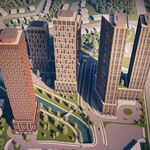Woodbridge_Heights
Senior Member
6-10 seems a little excessive. Even with 5 km station spacing you could go with stations at.
Finch/Hwy 400 (potential communter parking lot off the 400, could take pressure off of Yorkdale station). And connects with Transit City's Finch line.
Emery village/Islington and Steeles area. Mix of industrial and residential in this area. Depends on the final station location
Woodbridge. Multiple possible station locations, but I forsee 1 maybe 2 max stations through Woodbridge. Prob 407 and then further north near Woodbridge Ave. or Kipling Ave
Maybe, maybe one more station in the Rutherford Rd/Major Mackenzie stretch before.
Bolton.
Yes I have a vested interest in this line
Finch/Hwy 400 (potential communter parking lot off the 400, could take pressure off of Yorkdale station). And connects with Transit City's Finch line.
Emery village/Islington and Steeles area. Mix of industrial and residential in this area. Depends on the final station location
Woodbridge. Multiple possible station locations, but I forsee 1 maybe 2 max stations through Woodbridge. Prob 407 and then further north near Woodbridge Ave. or Kipling Ave
Maybe, maybe one more station in the Rutherford Rd/Major Mackenzie stretch before.
Bolton.
Yes I have a vested interest in this line




